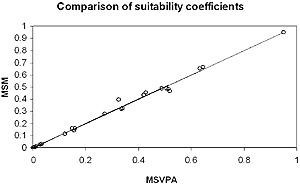Resource Ecology and Ecosystem Modeling Program
Testing the Stability of the Suitability Coefficients from the Eastern Bering Sea Multispecies
Virtual Population Analysis
Suitability coefficients are important for the estimation of predation mortality M2 in the multispecies virtual
population analysis (MSVPA) and the multispecies forecasting model (MSFOR) models. Testing the assumption of the
stability of the suitability coefficients is important to assess the robustness of the predictions made with MSFOR.
We used different statistical methods to partially test this assumption. The comparison of the estimates from two
different sets of data suggested that sample sizes greater than 200 reduce the differences between the two types of
estimates. In a second approach, we contrasted the residual variances of partial data sets with the results from the
fit of a combined data set. Results suggested a small effect (~10.8 %) of variation in stomach contents among years
on suitability estimates. The comparison of the fitted means of the suitability coefficients associated with each
predator species suggest that only 13 of the 50 pair-wise contrasts were significantly different (α = 0.05). In general,
results suggested that the predator preferences and prey vulnerabilities remained stable over time. Therefore, MSFOR
could be considered as a tool for providing advice to fisheries managers within a multispecies context.
By Jesús Jurado-Molina and Patricia Livingston
Incorporating Predation Interactions in a Statistical Catch-at-age Model for a Predator-prey System in the
Eastern Bering Sea
Multispecies virtual population analysis (MSVPA) has been used to model groundfish predation interactions in the
eastern Bering Sea. This model incorporates predation mortality, M2, into the virtual population estimation process.
However, this model framework lacks the statistical assumptions now commonly used in single-species assessment modeling
in which statistical fitting of parameters is accomplished by considering how errors enter into the model and multiple
data sources are used to estimate parameters. In this work, a two-species system (walleye pollock and Pacific cod) was
derived to incorporate the predation equations from MSVPA into a multispecies statistical catch-at-age model (MSM).
The MSM is a complex model that estimates population numbers and predation mortality based on catch-at-age data,
relative indexes of abundance, predator annual ration and predator stomach contents using estimation procedures for
the statistical part and the predation mortality. MSM statistically estimates population parameters such as numbers
at age and fishing mortality rates using either an optimization algorithm (Newton-Raphson for example) or Bayesian
methods and an internal algorithm for the estimation of the predation mortality.
| |

Figure 1. Comparison of estimates of average suitability coefficients for walleye pollock as predator
from the multispecies virtual population analysis and the multispecies statistical model. |
Results suggest that the multispecies statistical model reproduced most of the suitability coefficients (Fig. 1)
and predation mortalities estimated by MSVPA and the adult population estimates from the single-species stock assessment.
MSM also provides a measure of the uncertainty associated with these parameters, which is not available with the
current MSVPA technology.
MSM is an important advancement in providing advice to fisheries managers because it incorporates the current tools
used in stock assessment such as Bayesian methods and decision analysis into a multispecies context, helping to
establish useful scenarios for management in the eastern Bering Sea. Future improvements to the model will include
adding the full suite of groundfish predators presently modeled in the eastern Bering Sea MSVPA and incorporating
stomach content data into the statistical estimation process.
By Jesús Jurado-Molina and Patricia Livingston
>>>continued

|

|
Quarterly sidebar
AFSC Quarterly Research Reports Apr-June 2004
Contents
Feature
ABL Reports
NMML Reports
RACE Reports
REFM Reports
Quarterly Index
Quarterly Home
|

